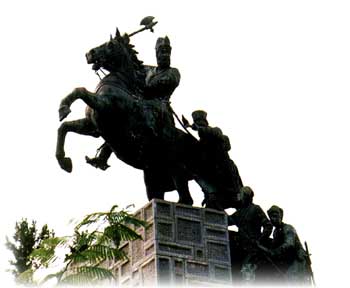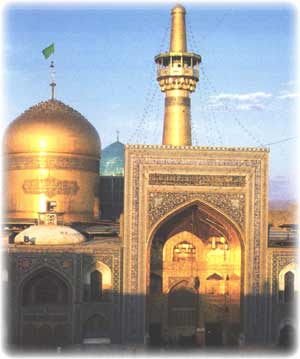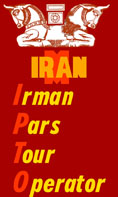|
The provincial capital of
Khorassan, Iran's largest province, is itselfThe nations second
largest city. It is also Iranís holiest city and a place of
pilgrimage For Shi'ite Moslems from all over the world.
Khorassan, one of Iran's most important provinces both
geographically and historically,once included parts of
Afghanistan,Tadjikestan, Turkomanistan and Uzbakistanunder the
entity of the Greater Khorassan. Itis also the cradle of the Persian
(Farsi)language and the civilization of eastern Iran,and the
homeland of many great Iranian poets, writers and scholars.Khorassan
s most recent history is associated with the Afshar Dynasty and its
founder Nader Shah Afshar. A number of edificesincluding the
Qasr-e-Khorshid (Sun Palace), scattered along the Kalat-e-Naderi,
where Nader Shah kept his headquarters, date from this period
(1736-1747). Nader is buried in Mashad in a modern mausoleum.Imam
Reza, the eight Shiite Imam, died in 818 AD. in the small village of
Sanabad in Khorassan, and was buried next to Abbasid Caliph,
Harun-al-Rashid. The Shi'ite believethat he was murdered, and his
tomb came to be known as Mashad, or the place of martyrdom. |
 |
Today pilgrims pass through chambers of glittering mirror
work and tiles to reach the tomb of Imam Reza. The chambers are always
filled with hundreds of people praying and reciting the Koran. Among
Iranian kings whocontributed to the building and decoration of the Imam
Reza Shrine is Shah Abbas I, who walked to Mashad from Isfahan, further
Demonstrating his devotion by covering thedome over the tomb chamber with
sheets of gilded copper in 1607.The mosque of Gowhar Shad stands to the
south, and to the left is the entrance portal to the old court also built
by Shah Abbas, capped by a small pavilion called the Naghareh Khaneh or
Drum Tower, where drums and trumpets daily salute the rising and setting
sun. The mosque built during the reign of Timurid monarch Shahrokh, by his
pious wife, Gowhar Shad between 1405 and 1418 is one of the finest in
Iran.The Imam Reza Shrine complex including one of the richest libraries
of manuscripts and hand written books, is truly one of the most
magnificent religious centers anywhere in the world.
TOOS: Iranís greatest epic poet Ferdowsi, is buried
at Toos, near Mashad where his statue also stands. Almost
every Iranian can recite part of the Shahnameh or Book of Kings, composed
in 994 ND., in which Ferdowsi recounted in 60,000 verses the early history
of Persia.TORBAT-E-JAM: Sheikh Ahmad-ibn-Jami was a Sufi theologian and
poet who spent most of his life in the small town of Torbat-e-Jam, in
eastern Khorassan named after the saint. After his death in 1142, the
shrine expanded around the humble unroofed tomb of the Sheikh with the
addition of a tall portal and mosque built in 1440. Almost
every Iranian can recite part of the Shahnameh or Book of Kings, composed
in 994 ND., in which Ferdowsi recounted in 60,000 verses the early history
of Persia.TORBAT-E-JAM: Sheikh Ahmad-ibn-Jami was a Sufi theologian and
poet who spent most of his life in the small town of Torbat-e-Jam, in
eastern Khorassan named after the saint. After his death in 1142, the
shrine expanded around the humble unroofed tomb of the Sheikh with the
addition of a tall portal and mosque built in 1440.
TAEIBAD: The border crossing point from Afghanistan
into northern Iran which contains one of the finest Timurid structures in
the country. The Maulana Mosque and Shrine were built in the early 15th
century, probably under Shahrokh, the fourth son ofTamerlane, to honour
the remains of Sheikh Aain-al-Din, a local mystic who died several
centuries before.
ROBAT-E-SHARAF:
One of the oldest and most elaborate caravanserais, a masterpiece of
Seljuq architecture, built about 1120 AD. The trade routes of the twelfth
century have shifted, leaving the splendid structure standing alone among
low hills north east of Mashad. The complexity of Robat-e-Sharaf suggests
that it may have been used by the Seljuq rulers as a temporary
residence.
KHWAF: The villagers
of southern Khorassan have developed through the centuries an efficient
device for harnessing the desert wind to grind their grain into flour.
Khwaf was an important center during the 10th century A.D., famous for its
fruits and silk. Besides the wind mill, another place of interest in Khwaf
is the Khargerd Madrasseh built during the reign of Shahrokh about
1444-45, still retaining some fine
tilework. |

